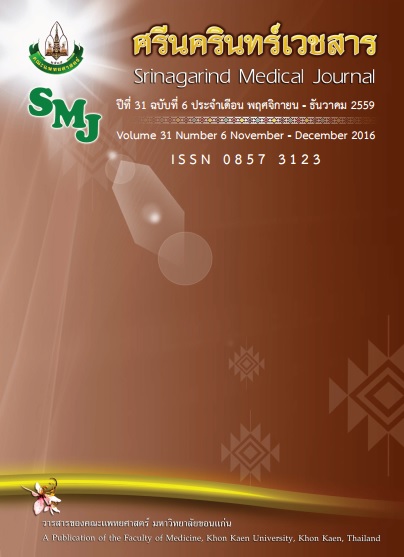Self -Management Telehealth Innovation for Patients with Diabetes Mellitus Type 2 with Dyslipidemia
Abstract
นวัตกรรมเพื่อการจัดการตนเองผ่านระบบบริการสุขภาพทางไกลสำหรับผู้ป่วยเบาหวานชนิดที่
2 ที่มีภาวะไขมันในเลือดสูง
หลักการและวัตถุประสงค์: ผู้ป่วยเบาหวานที่ไม่สามารถควบคุมระดับน้ำตาลได้ มักพบปัญหาไขมันในเลือดสูงร่วมด้วย ปัญหาส่วนหนึ่งเกิดจากรูปแบบการดูแลที่ให้ข้อมูลที่เฉพาะเจาะจงกับผู้ป่วยแต่ละรายและตอบสนองความต้องการข้อมูลที่ต่อเนื่องยังไม่พัฒนาใช้แก้ปัญหาดังกล่าว การศึกษานี้มีวัตถุประสงค์เพื่อพัฒนานวัตกรรมเพื่อการจัดการตนเองผ่านระบบบริการสุขภาพทางไกลสำหรับผู้ป่วยเบาหวานชนิดที่ 2 ที่มีภาวะไขมันในเลือดสูง
วิธีการศึกษา : การพัฒนานวัตกรรมใช้การทบทวนวรรณกรรมและการสืบค้นหลักฐานเชิงประจักษ์ กลุ่ม
ตัวอย่างคือผู้ป่วยเบาหวานที่มารับการรักษาที่คลินิกเบาหวาน ได้มาโดยการสุ่มอย่างง่าย 50 คนแบ่งเป็นกลุ่มทดลองและกลุ่มควบคุม กลุ่มละ 25 คน เครื่องมือในการวิจัยประกอบด้วยโปรแกรมการจัดการตนเองที่ส่งผ่านโทรศัพท์มือถือด้วยโปรแกรม Line และคู่มือการจัดการตนเองที่พัฒนาจากกรอบแนวคิดการจัดการตนเอง ประเมินผลการใช้นวัตกรรมด้วย คะแนนพฤติกรรมการจัดการตนเอง ผลตรวจระดับน้ำตาลก่อนอาหาร (FBS) ระดับน้ำตาลสะสม (HbA1C) ไขมันในเลือด 3 เดือนหลังการทดลอง วิเคราะห์ข้อมูลโดยใช้ความถี่ร้อยละ ค่าเฉลี่ย ส่วนเบี่ยงเบนมาตรฐาน ค่าฐานนิยม สถิติ Independent t test , Pair t test , Wilcoxon matched pairs signed rank test และ Mann whitney two sample test
ผลการศึกษา : ผู้ป่วยกลุ่มทดลองมีคะแนนพฤติกรรมการจัดการตนเองหลังการทดลองที่สูงกว่าก่อนการทดลองอย่างมีนัยสำคัญทางสถิติ (p ≤ 0.05) และสูงกว่ากลุ่มควบคุมอย่างมีนัยสำคัญทางสถิติ (p ≤ 0.05) สำหรับผลตรวจทางห้องปฏิบัติการพบว่า ค่าเฉลี่ยของระดับน้ำตาลในเลือดขณะอดอาหาร (FBS) และค่าเฉลี่ยน้ำตาลสะสม ของผู้ป่วยกลุ่มทดลองภายหลังทดลอง ต่ำกว่าก่อนการทดลองอย่างมีนัยสำคัญทางสถิติ (p ≤ 0.05) และต่ำกว่ากลุ่มควบคุมอย่างมีนัยสำคัญทางสถิติ (p ≤ 0.05) ระดับไขมันคลอเลสเตอรอล (cholesterol) และระดับไขมันไตรกลีเซอรไรด์ (triglyceride) ของกลุ่มทดลองหลังการทดลองต่ำกว่าก่อนการทดลองอย่างมีนัยสำคัญทางสถิติ (p ≤ 0.05)
สรุป : นวัตกรรมการจัดการตนเองการจัดการตนเองผ่านสื่อระบบทางไกลมีประสิทธิภาพต่อพฤติกรรมการจัดการตนเองและช่วยให้ผู้ป่วยเบาหวานสามารถควบคุมระดับน้ำตาลในเลือดได้
Background and Objectives : Patients with type 2 diabetes (T2DM) which have poor glycemic control usually have dyslipidemia. Individual health counseling and continuing care were not developed properly. This study aimed to develop self -management telehealth innovation for diabetes mellitus type 2 patients who have dyslipidemia.
Method Innovation was developed based on evidence based knowledge. Quasi experimental design was used as methodology. Fifty patients were recruited as sample from diabetic clinic, Srinagarind Hosptial, and were randomized into intervention group (n = 25) and control group (n = 25) group. Research instrument consisted of self-care management program which was developed for sending information via Line application of smartphone. Self-care behavior and blood sample for fasting plasma glucose (FPG), HbA1c and lipid profiles were measured at baseline and 3 months. Independent t-test , Pair t-test , Wilcoxon matched pairs signed rank test and Mann whitney U test were used for data analysis
Results :. At the end of the program, mean of self care behavior score in experimental group was significantly different from control group. FPG, HbA1c, total cholesterol and triglyceride levels were decreased significantly from baseline in intervention group. Only HbA1c and total cholesterol levels were significant lower in intervention group compared to control group.
Conclusions : This study supported that telehealth innovation improve self-care behavior, glycemic control as well as lipid profiles in T2DM. This technology is a promising approach to caring the patients who have difficulty in controling dyslipedimia.




